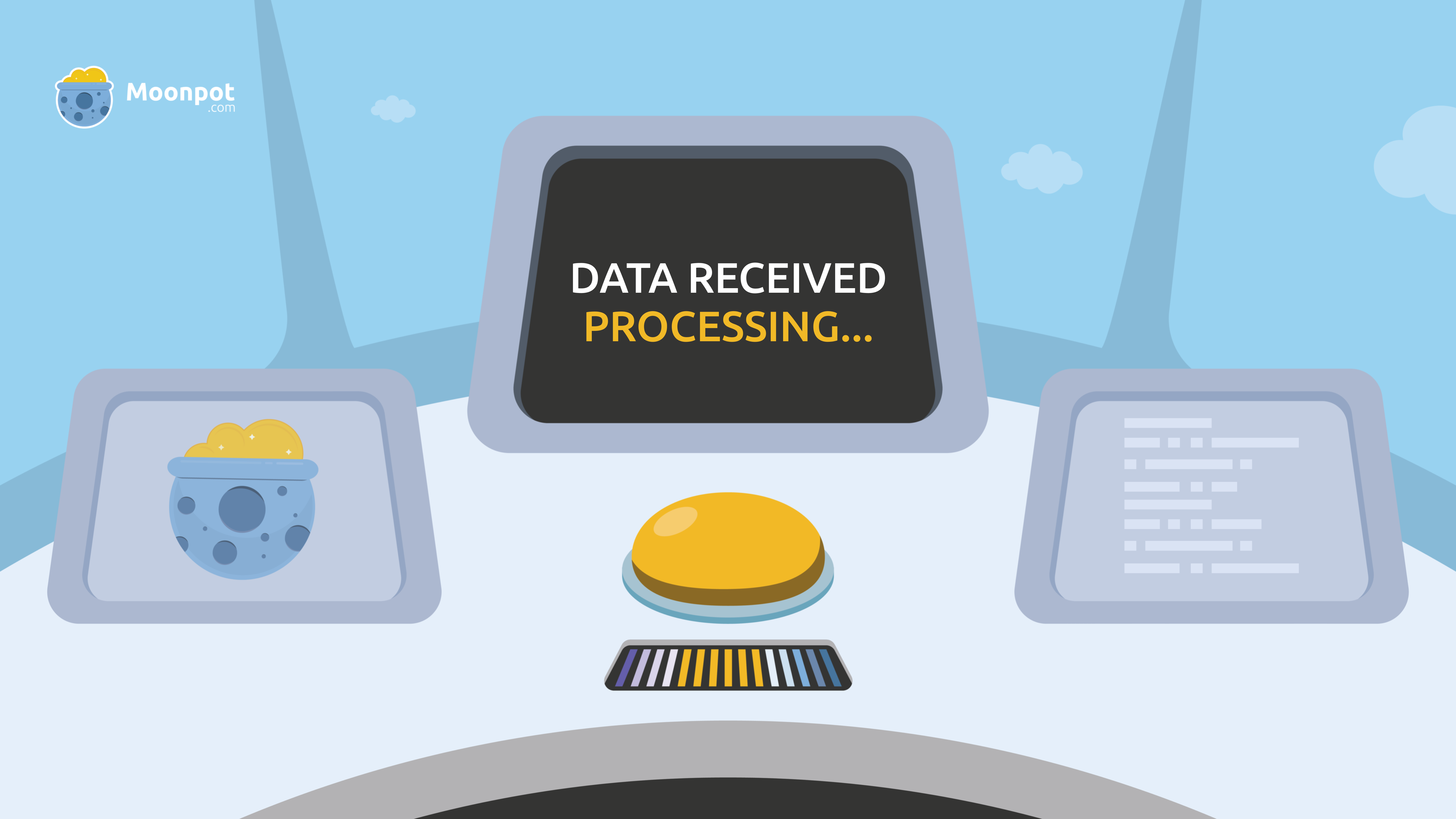
Today is another big day at Mission Control thanks to the imminent launch of our LP Pots.
That’s right, Cadets. You will soon be able to stake your POTS LP tokens in a Moonpot to earn daily yield on your holdings AND the chance to win the weekly LP Pot prize draw.
Captain Ziggy assumes you’ve attended all his previous lessons so you already know about liquidity pools and LP tokens. If not, please read our entry on the topic here.
Because in this edition of Moon Academy we’re going to take a closer look at the concept of Impermanent Loss, which is the main risk you need to understand in this brave new LP world.
We hope you brought your calculator because there’s some math involved.
Class is in session.
What is Impermanent Loss?
That’s a great question, Cadet.
In basic terms Impermanent Loss refers to a situation in DeFi where the assets you’ve put in a liquidity pool end up being worth less than if you had simply kept them in your wallet.
 There’s quite a lot to unpack there if you’re new to this, but let’s use Moonpot as an example.
There’s quite a lot to unpack there if you’re new to this, but let’s use Moonpot as an example.
There are two main places to buy POTS right now: PancakeSwap and ApeSwap. Both are decentralized exchanges (DEX) known as automated market makers. So there’s no order book or need for someone else to be on the other side of your trade. Instead there’s a ‘liquidity pool’.
This is where users go to buy/sell their tokens. Imagine a massive pile of two tokens that together make up the market and provide the liquidity needed for decentralized trading.
So on PancakeSwap there is a POTS-BUSD liquidity pool.
And on ApeSwap there is a POTS-BNB liquidity pool.
This means anyone can buy or sell either of those tokens for the other. Essentially you put in one side of the pair, so BUSD (or BNB), and then take out POTS — or vice versa. The smart contract’s algorithms then automate the running and rebalancing of the pool.
This is where Impermanent Loss comes in if you are one of the people providing liquidity.
Say what? Well, because all of this is decentralised, the assets in the pool come from anyone who wants to provide their tokens as liquidity. All you have to do is go to the platform you want to provide liquidity to and then deposit the two tokens that make up that pool.
 So in the case of Pancake Swap you would deposit POTS and BUSD into its POTS-BUSD liquidity pool. And for ApeSwap you would deposit POTS and BNB into its POTS-BNB liquidity pool. Note that when providing liquidity the USD amount of each token has to be the same.
So in the case of Pancake Swap you would deposit POTS and BUSD into its POTS-BUSD liquidity pool. And for ApeSwap you would deposit POTS and BNB into its POTS-BNB liquidity pool. Note that when providing liquidity the USD amount of each token has to be the same.
You can already do this directly on Beefy Finance, with their Zap function. Learn how to do that, here.
OK, so now you are a liquidity provider.
But here’s The Thing, if the price of one (or both) of the tokens you’ve put into the liquidity pool makes a move, up or down, your deposited assets can end up being worth less than if you had just held the tokens in your wallet. Oftentimes this opportunity cost is outweighed by the interest you will earn for providing liquidity. When you do earn less that you could have, this is what is known as impermanent loss.
This is something you really need to understand before choosing to become a liquidity provider. Because a change in the price ratio of the two tokens will always lead to impermanent loss.

Why does Impermanent Loss happen?
It’s all the algorithm’s fault, Cadet.
Remember, there’s no central authority or order book. So for the liquidity pool to function in such a way that trades are always available there’s an algorithmic formula that ensures the ratio of tokens within the pool remains balanced at all times. This is how market making is automated.
So for PancakeSwap and ApeSwap the token pairs in the liquidity pools must be of equal total value at all times. And because the formula cares about this ratio balance more than anything else it can lead to a situation where the value of your assets inside the pool end up being less than if you had kept them outside the pool. Or, as it is now popularly known, Impermanent Loss.
Still not clear? OK, let’s do the math…
You understand that the liquidity pool is run by an algorithmic formula, right? And that algorithm exists to ensure the ratio of tokens within the pool remains balanced at all times, yes? OK, good.
So, the specific formula that maintains the pool’s balance of equal values is: x*y = k
Or for those that don’t do math, Token A multiplied by Token B must equal Amount C. And, on top of that, Amount C needs to stay the same regardless of what is happening to A and B.
 Let’s get even more specific and apply this to PancakeSwap’s POTS-BUSD liquidity pool.
Let’s get even more specific and apply this to PancakeSwap’s POTS-BUSD liquidity pool.
According to the formula, the total value of all the POTS in the pool must always equal the total value of all the BUSD in the pool. Maintaining the equal value relationship between the two tokens is the entire basis of the automated pricing mechanism, and what makes it all work.
The pool is made up of 50% POTS and 50% BUSD. When someone comes to buy POTS for BUSD the amount of POTS in the pool decreases while the amount of BUSD increases.
The pool is now out of balance so the formula increases the price of POTS relative to BUSD so the value of the pool’s POTS is again equal to the value of the pool’s BUSD.
Let’s make this even clearer by using actual numbers.
Pretend you are the only liquidity provider in PancakeSwap’s POTS-BUSD liquidity pool. This would never happen but explaining it this way will make things much easier to understand.
Imagine that at the time of entering this liquidity pool 1 POTS is worth $10, or 10 BUSD.
You choose to supply the pool with 100 POTS and 1,000 BUSD thereby adhering to the 50-50 rule. And providing $2,000 worth of value.
 According to the formula the balance that must be kept can be found by multiplying the two token amounts. In this case 100 x 1,000 = 100,000. This is the balance that must be kept.
According to the formula the balance that must be kept can be found by multiplying the two token amounts. In this case 100 x 1,000 = 100,000. This is the balance that must be kept.
Now let’s say the price of POTS triples to $30. So now 1 POTS = 30 BUSD
Based on the algorithmic formula the liquidity pool rebalances so that there are now 57.735 POTS and 1,732.05 BUSD.
In dollar terms the 57.735 POTS are now worth $1,732.05. And the BUSD side of things is also worth $1,732.05. Balance has been kept.
The ratio is still 50-50, and the formula has also kept the constant.
Because 57.735 x 1,732.05 = 100,000, thereby matching the 100,000 amount we started with.
All is well with the world. And your assets in the pool are now worth $3,464.10 compared to the $2,000 you put in.
But what if you had simply held these assets in your wallet?
Your original 100 POTS would now be worth $3,000, and your 1,000 BUSD would be worth $1,000 — this gives you a combined total of $4,000
And so there, Moonpot Cadets, is your Impermanent Loss.
 Had you kept your original assets in your wallet you would have ended up making $535.90 more than you did putting them in the liquidity pool.
Had you kept your original assets in your wallet you would have ended up making $535.90 more than you did putting them in the liquidity pool.
$4,000 of value if you had held your assets versus $3,464.10 of value in the liquidity pool.
Remember: if the price of one or both of the tokens in the pool makes a move, up or down, your assets can end up being worth less than if you had simply held the tokens in your wallet.
A few things to note.
This is an extreme example because you will never be the only liquidity provider in a pool.
Further, in the example above you still increased the USD value of your assets in the pool. Just not as much as if you had held them in your wallet. So this wasn’t strictly a loss.
More a non-optimal outcome.
And it’s impermanent because if the prices go back to where they were when you entered the pool the “loss” is reverted. This is rare, however.
Due to the nature of crypto it’s much more likely that token prices move. And the bigger the difference between assets in the pool, the bigger the impermanent loss.

Why be a liquidity provider if you can suffer Impermanent Loss?
Well, for money, basically. Because anyone who provides liquidity to a pool earns a share of the total trading fees (proportional to their share of the pool).
Every time a user makes a trade from the pool they have to pay a small fee. And that money is then paid to all the liquidity providers as a reward for staking their tokens in the first place.
The way this is tracked is by giving everyone who provides liquidity a new token to represent their deposit. This is what’s known as a Liquidity Provider token, or Liquidity Pool token.
You can just call them LP tokens.
And so — in short — if there is enough trading volume and platform rewards, the interest you earn by being a liquidity provider can more than make up for any impermanent loss you encounter along the way.

Why are you telling me all this?
Because very soon, dear Cadet, we will launch our LP Pots. This is where you can stake the tokens you receive for being a liquidity provider to earn extra yield and be in the weekly prize draw. Win-win.
As mentioned, PancakeSwap has a POTS-BUSD liquidity pool. So you would deposit an equal USD amount of both tokens and receive liquidity pool tokens called POTS-BUSD LP.
These tokens represent your deposit, and portion of the pool.
In the case of ApeSwap you will be staking POTS and BNB in their liquidity pool, and receiving POTS-BNB LP tokens as a way of marking your deposit and earning from fees.
And now, thanks to Captain Ziggy, you can stake POTS-BUSD LP in our POTS-BUSD LP Moonpot, and POTS-BNB LP in our POTS-BNB LP Moonpot.
Both Pots will give you bank-beating interest on your assets. And there will be a prize draw for both Pots every single Thursday with big-money prizes paid out in crypto.
We just wanted to make sure you fully understood Impermanent Loss before you rushed off to get your LP Tokens. Because there is of course a chance your assets are worth less in a pool than if you had simply held them in your wallet. You have been warned. There are no excuses to come crying to Mission Control about impermanent loss if you’ve not done your homework.

How can I join the LP Pot if I don’t have any LP tokens?
To make the process of joining the LP Moonpot as easy as possible, we’ve simplified the tedious process of staking POTS or BNB yourself. With our Zap feature, all you will need is either POTS or BNB. That’s it… we’ll do the hard work for you!
Zap makes the process of entering liquidity pools incredibly simple. Usually, you’d need two coins in equal amounts. Then, you’d need to enter both of them into a liquidity pool on a DEX like PancakeSwap to receive LP tokens. With Zap, you don’t even need to leave the Moonpot website.
If you only have one coin in the LP pair, Zap will exchange half of your tokens for the other token you don’t have before putting them both in the liquidity pool. When you later remove your funds, you can also choose to receive your stake in either one coin or both. It’s the most flexible and simple way of entering liquidity pools in the DeFi space.
To use Zap, you will simply click the token icon in the [Enter amount] field of the LP Moonpot. You’ll then see the option to add LP tokens or let Zap convert your individual assets into crypto.